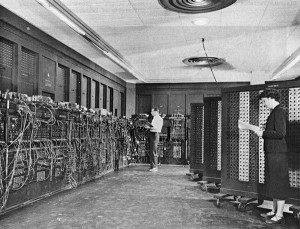Ever wonder what the world’s first electric computer looks like? Pictures and design schematics were originally classified due to the fact that it was used for military purposes. Thanks to the efforts of American businessman and presidential candidate Ross Perot, however, you can view this archaic machine in person at Fort Still in Oklahoma.
The Electronic Numerical Integrator And Computer (abbreviated ENIAC) was developed by the U.S. government in the early-to-mid 1940s to bolster the Allied forces ability to fight the Nazis. This wasn’t your typical modern-day computer, but instead it was used specifically for calculating trajectory paths of artillery and validating the hydrogen bomb’s design. Because of the sensitive nature of this machine, the U.S. government kept it classified up until recently.
According to the Smithsonian Museum, the ENIAC was a beastly machine, tipping the scales at nearly 30 tons (60,000 pounds). Featuring a U-shaped design consisting of 40 cabinets, 18,000 vacuum tubes, 10,000 capacitors, 6,000 switches, and 1,500 relays, it filled a 1,500-square-foot-room. Officials who worked on the ENIAC compared it to a telephone exchange, as they both possessed a network of patch cords and tangled wires.
So, what role did Ross Perot play in the ENIAC’s resurrection? Perot reportedly asked his staff members to decorate his business office with history computers. When ENIAC was decommissioned several decades ago, however, it was broken up into dozens of pieces, many of which were lost due to poor record keeping. Nonetheless, Perot’s staff were able to track down eight of the panels.
The ENIAC system was badly damaged when it arrived at Perot’s office. Staff members created a motion-sensor that blinked each time a person walked by, giving the system at least some level of functionality. However, Perot decided that the ENIAC was a piece of history, at which point he shipped the dated computer to Fort Still in Oklahoma.
Unfortunately, the ENIAC is only partially restored, meaning you won’t be able to view it in its original form. “The museum piece won’t replicate the 1945 system in its full glory (it’s missing most of the 40 original panels), but it’ll give you a sense of what you missed. Restoration gurus Dan and Jonathan Gleason linked hundreds of bulbs to a motion sensor to make it look active when you wander by,” wrote Engadget. If you want to see the partial system though, it remains on display at Fort Still.
 Offtek Blog Your source for everything memory
Offtek Blog Your source for everything memory

